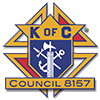Number 6 December 2023
‘Tis the season to be jolly as it is often said. It is a time for Christmas trees and holly, a time for eggnog, hot cider, and hot chocolate; a time for gift giving and receiving, good cheer and great joy. Christians celebrate the birth of the Savior. In the northern hemisphere it is generally cold and the days grow shorter. People talk and even sing of a “white Christmas. Our friends in the Southern Hemisphere are experiencing the heat of summer and the days are getting longer. So why do we celebrate Christmas in December?
The story of the birth of Christ is told in the Gospel of St. Luke. He gives us the most detailed story including the Annunciation when the angel appeared to Mary. He writes about the visit of Mary to Elizabeth. He also writes about the journey to Bethlehem, the birth in the manger and the flight to Egypt. Luke writes about an angel appearing to shepherds tending the flocks of sheep at night in the fields. Luke answers the “Who”, “What”, “Where”, and “Why.” What Luke does not tell us is the “When.” His only clue about “When” is the shepherds. It is highly unlikely that they would be in the fields at night in December. It would be cold and there would be very limited forage for the sheep.
Our celebration of Christmas can be traced back to at least 753 BC and possibly much earlier. The year 753 BC marks the beginning of the Roman kingdom. Among other gods the Romans worshipped the sun which they called Sol. The Romans identified the winter solstice as the day of the year with the least hours of daylight. The winter solstice was identified and celebrated as the “Birth of the Invincible Sun.” We know the solstice occurs about December 21st. In Roman times the days of the year were a bit flexible. The solstice could have occurred on any of several days of their calendar. In any case the day was known as the day the sun was reborn. The Romans marked the day with feasting and gift giving.
The early Christian church recognized the value of incorporating pagan celebrations and customs as a means of evangelism. It is a simple step to substitute “son” for “sun” in English. Latin is not so easy, but the story is the birth or rebirth of a god.
There is irrefutable evidence that the winter solstice was observed with ceremonies of various forms throughout Europe for thousands of years. The term “Yule” is derived from several Celtic words in many dialects, many of which mean “turning.” It was used to recognize the “turning” from shortening days to lengthening days. A Yule Log was a special log to be burned on the solstice. People living along the seacoast know that the tide ‘turns. Therefore, the term ‘Yule Tide’ refers to when the days turn.
Just as the solstice was celebrated in different ways across Europe under the Romans, we observe the Christmas season with various forms of celebration. Some leave a lit candle in a window to guide the Holy Family to a welcoming home. In Scandinavia a daughter is tasked with rising early baking sweet rolls and serving the rest of the family breakfast in bed with the rolls and hot chocolate. She might wear a crown of evergreens with lighted candles in honor of St. Lucia who brought food to those Christians hiding in the catacombs during the persecutions in Rome. Many of us look forward to a visit by Santa Claus, the name is a corruption of the Dutch name for St. Nicholas, an early church bishop who was rumored to reward good children with gifts of money and the bad with shoes full of coal. We hang stockings by the fireplace because no one wants to put shoes outside where they might freeze or end up buried in a Christmas snowfall. Fir trees, holly and mistletoe are signs of the holiday because they maintain their green needles and leaves all winter long.
Our Hispanic brothers as well as our Eastern Orthodox brother Christians may delay their celebrations until January 6th commemorating the arrival of the Magi. The Gospel of St. Luke does not mention the coming of the Magi. Their story is found in the Gospel of St. Matthew. He tells us that they came from the East and brought gifts of gold, frankincense, and myrrh. St. Matthew does not tell us when the Magi arrived or even how many were in their party, nor does he name them.
I remember when I was very young that our tree went up two weekends before the 25th and came down around New Years Eve. The tree was beginning to dry out and becoming a fire hazard. My wife’s family put up their tree Christmas Eve and left it up until January 6th. We compromised. Since my daughter was allergic to pines, we used an artificial tree. Limited fire hazard. The tree went up the weekend after December 11th and stayed up until January 6th. December 11th is one of my son’s birthday and it took him a year or two to learn that there was a difference between birthday presents and Christmas presents.
We wish you and all your family a very Merry Christmas and a Happy New Year. And for my Spanish-speaking brothers – una muy Feliz Navidad y un Próspero Año Nuevo

